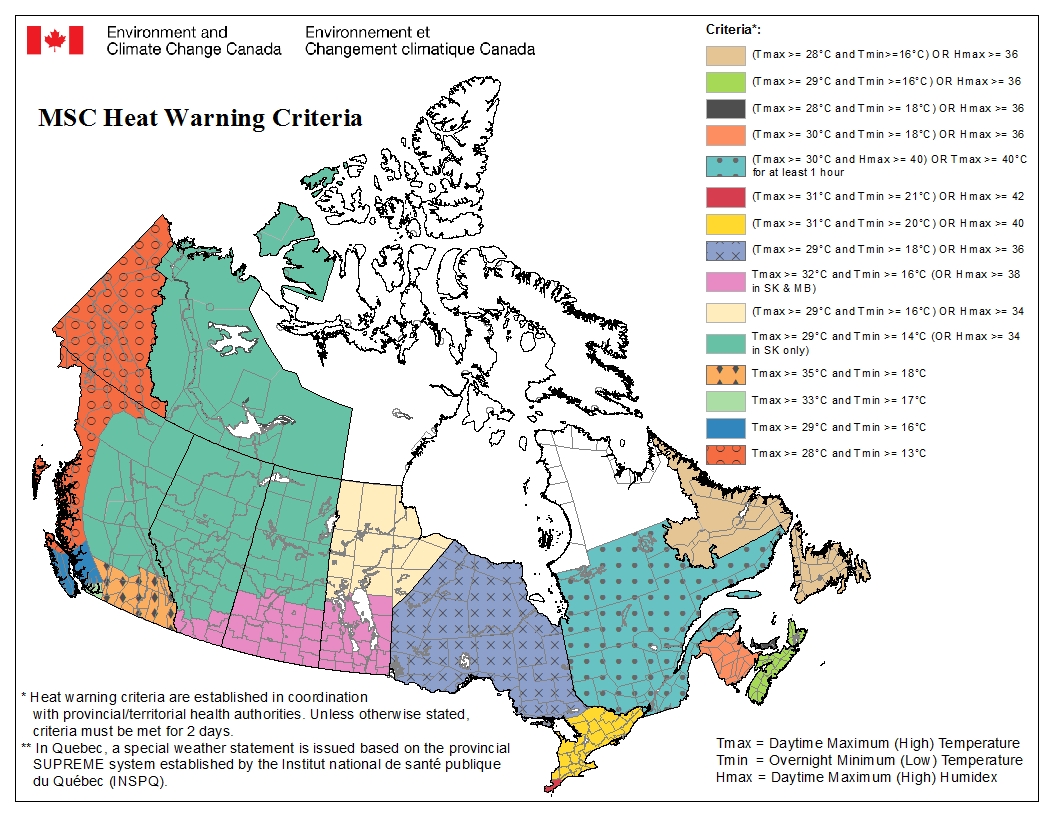Why are heat warning criteria different across Canada?

Posted July 9, 2023 1:04 pm.
Last Updated July 9, 2023 1:06 pm.
A map of Environment Canada’s heat warning criteria for all provinces and territories is a cornucopia of colours and codes.
Most of B.C., Alberta and Saskatchewan are teal; Manitoba is half beige, half pink; most of Ontario is navy blue, while southern Ontario is yellow and red.
That’s because heat warning criteria – the weather parameters that must be met in order for a heat warning to be issued – vary from region to region. But why is that the case exactly?
A meteorologist from Environment and Climate Change Canada says it all boils down to “regional climatology.”
“Across Canada, it’s quite great, so Health Canada, in collaboration with Environment Canada, created various criteria that are regionally specific, and regionally appropriate for areas and provinces across the regions,” Heather Pimiskern told CityNews.
In Quebec, for instance, a heat warning is issued when the humidex value is 40 degrees Celsius or higher and when the temperature is 30 C or warmer – with both persisting for at least one hour.
In northern Manitoba, a warning is issued when there are two consecutive days of daytime temperatures expected to reach 29 C. The threshold is 32 C for southern Manitoba.
“In Alberta for example, we have two separate criteria,” said Pimiskern. “One has to do with daytime high maxes of 29 degrees with overnight lows of 14 degrees or warmer. And that’s pretty much applicable to the majority of the province with exception of regions right along the U.S. border where daytime high temperatures oftentimes in the summertime are much warmer. So we have criteria that reflects that.”
Pimiskern says regional climatology criteria are based on 30-year averages. She says the possibility of updating those criteria is continually being monitored.
“However change is again in collaboration with Health Canada, and it is something that the two organizations need to determine and established, so it’s not something that is changed on a whim, but has to be based on a scientific background.”
Heat warnings across Canada
Heat warnings were in place in six provinces and two territories Sunday, as a heat wave continued to grip most of Canada.
Temperatures were forecasted to soar near or above 30 C into Monday for parts of southern and coastal British Columbia, with the highest temperatures in some areas expected to hit 35 degrees.
Last week saw Canada record two unofficial hottest days in human recordkeeping, according to University of Maine scientists at the Climate Reanalyzer project. For two straight days, the global average temperature spiked into uncharted territory.
“We have heat warning criteria across the country because it is possible to see it everywhere,” said Pimiskern. “Even up north, north of the sixth parallel, it is possible to see temperatures well above normal, and that can have adverse effects on the individuals who are beneath that heat.”
RELATED:
- Canada expected to break heat records for third day in a row
- Is this the climate tipping point?
- Monday may have set a global record for the hottest day ever. Tuesday broke it
- Albertans can likely expect more wild weather throughout summer: ECCC
In Alberta on Sunday, most of the province was covered under a heat warning; daytime highs were expected near 30 degrees before moderating on Monday.
“This summer has certainly been abnormal in the sense that we’ve had persistent upper ridges sitting over the province of Alberta,” said the Environment Canada meteorologist. “So what that generally means is we have warm air that affects northward into the region, and just sits overtop of Alberta. And so that tends to allow temperatures to climb to temperatures that are much higher than normal.
“The normal temperature for this time of year is around 23 degrees in Edmonton, and in the last couple of days we have seen temperatures have been around 27-28 degrees, and so it’s been encroaching on that heat warning criteria, which is why it’s in place over Alberta.”
Edmonton has been issued four heat warnings so far this year – the earliest was May 2 while the latest in ongoing.
Health Canada says it’s important to check on the members of the population more susceptible to heat issues, including seniors, children and pregnant women, and pets.
Experts recommend watching for the effects of heat illness (swelling, rash, cramps, heat exhaustion, heat stroke), drinking lots of water and taking breaks from the sun.









